By Tom Travis
Dreaming, re-imagining and visioning for neighborhoods were at the center of a recent discussion of the University Avenue Corridor Coalition (UACC).
Focused on neighborhood revitalization and blight removal, a project funded by a small federal grant is being directed toward envisioning possibilities for a historic neighborhood in the heart of Flint.
UACC leaders and others say they hope the project, calling for several other community meetings, will carry over into other neighborhoods in Flint.
Called the Durant-Tuuri-Mott Area Vision Project, the initiative began in the Fall of 2019 when the Genesee County Land Bank got a grant to bring in a team from Michigan State’s School of Planning, Design and Construction.
The team’s goal was to open up conversations about neighborhood revitalization. As a pilot project, the team is first concentrating on the Durant-Tuuri-Mott (DTM) target area. (The DTM target area includes part of the Carriage Town Historic Neighborhood as well.)
The UACC is a coalition of about 15 organizations, along with Carriage Town Ministries and Kettering University. Its mission, according to the Kettering University’s website, is “To make the University Avenue corridor an attractive and crime-free community that is conducive to sustainable development by addressing quality of life issues (blight, crime, health, social, and education) using strategic collaboration.” (More about the UACC can be viewed here.)
The DTM Vision Project was a topic at a recent UACC meeting, where Wayne Beyea, a senior specialist of the MSU School of Planning, Design and Construction, guided a discussion. Beyea has been contracted by the Land Bank to develop the Vision project.
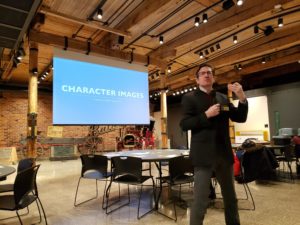
Wayne Beyea, Senior Specialist of MSU’s School of Planning, Design and Construction presents results from Community Input at the last UACC meeting.
Funding for the project goes back to 2012 and the Obama administration, when the Department of Justice initiated grants awarded to municipalities across the country. Flint was awarded one of those grants, called the Byrne (pronounced ‘burn’) Criminal Justice Innovation.
Beyea called the project “The Sustainable Built Environment Initiative” and defined the project as, “Assisting communities to address physical planning, design, and land use issues. It offers a graphic visioning process that provides citizens with a set of images and recommendations to guide improvements in their community with a sustainability theme.” He pointed out that the project does not provide final design or cost estimates for recommended improvements.
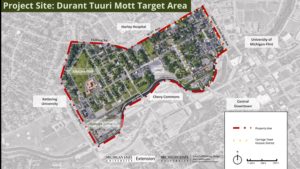
The red outline depicts the target area for the Durant-Tuuri-Mott target area revitalization project.
The project’s scope is to re-imagine what a thriving, vibrant Durant-Tuuri-Mott target area could look like and to better understand the steps it will take to get there. The group’s approach will be to select vacant parcels to be looked at in a conceptual, visual manner by focusing on potential reuse opportunities and visual appearance.
The exciting aspect for the rest of the city of Flint is that this will use this visioning process as a launching pad for the target area and community.
Upcoming community gatherings, like the one at the UACC monthly meeting, will aim to summarize existing neighborhood conditions and to gather community input. In addition, recommendations for physical improvements will be gathered from the community. Finally the group hopes to identify opportunities and action steps to implement the plan.
The community meetings started in the Fall of 2019 and will go on through the summer of 2020. In November 2019 as community members and neighbors gathered, they were asked to write one word on a card to describe the Durant-Tuuri-Mott (DTM) target area as they currently see it. Then they were asked to write a one word description of how they would like to see the neighborhood in the future.
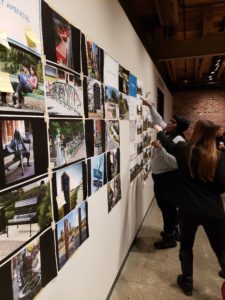
Community members and residents of the neighborhood revitalization target area of Durant-Tuuri-Mott place post-it notes on suggestions of things they’d like to see in their revitalized neighborhood.
Some of the things the participants wrote down to describe the DTM target area as they currently saw it were, “Fledgling, Quiet, Diverse, Underutilized, Repaired, Enigmatic, Emerging, Potential, and Shaky.”
For the one word descriptions of the future of the DTM target area they wrote, “Thriving, Healthy, Amazing, Active, Liveable, and Full.”
Table discussions centered around questions like, What are you proud of about the DTM area? What are you sorry about in the DTM area?
Then the participants were asked to imagine they were floating in a hot air balloon over the DTM target area in 15 years– What would they see?
Some of the responses were rehabilitation work, removal of blight, friendly neighbors, sense of place, historic houses, new people moving in, trail, and diversity.
Beyea explained the project focuses on three goals: revitalization, connectivity and placemaking.
Revitalization, Beyea proposed, would be achieved by redefining the usage of vacant lots to improve the quality of life of the residents. They plan to explore new potential usage of vacant properties, develop vacant lots into liveable spaces and provide diverse and attractive destinations to contribute to economic growth.
Connectivity, he explained, would be improved by considering diverse transit modes including walkable and bikeable street development, increase safety and personal security.
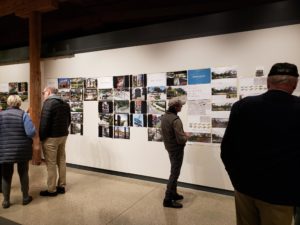
Community members and residents of the Durant-Tuuri-Mott neighborhood view input from previous meetings that had been posted on the wall.
Finally, he described placemaking, a new word being invoked in neighborhood redevelopment.
In a 2017 article, Kaid Benfield defines placemaking as, “the building or strengthening of physical community fabric to create great human habitat.”
For this project in the DTM target area, Beyea said, the MSU group defines placemaking as actions designed “to unify features of the build environment to promote social engagement, health, and safety, and to enhance a sense of place.”
Those promoting the neighborhood revitalization plan say they hope to bring sustainability in all areas of the project, including ecological, social and economic aspects.
Moses Timlin, Genesee Land Bank’s Neighborhood strategy coordinator, participated in the UACC meeting. Timlin was asked if the DTM Vision Project is something that could be carried over into other Flint neighborhoods that struggle with crime and blight. Timlin answered, yes, it is part of the desire of what is called the Community Development Working Group (CDWG).
Timlin described the working group’s process as, “Originating in 2016 to identify what resources may be needed to support neighborhood community development in light of the water crisis, the Flint CDWG evolved to proactively assess and advance solutions to macro-level challenges impeding the development of Flint’s neighborhoods as attractive places for residents to live and invest.”
Timlin said, “The CDWG has met over the past few years and asked the question, why is housing rehabilitation not happening in Flint?”
“And after doing an extensive survey what they found, which I think is not a surprise to many, is that the amount of money it took to rehab a home and to see its assessed value afterwards was only a marginal increase,” Timlin said. “So on average people are investing $70K into their home but only seeing a marginal increase of value of $45K.
He said what the working group decided to do was “to pick one specific target area where we bring all the organizations together and focus their programming on this area. And so the first area neighborhood chosen was this Durant-Tuuri Mott target area because it’s adjacent to downtown with two anchoring institutions, Kettering University and Hurley Hospital.
“We wanted to take the lessons learned in this target area and then with the hopes of this is just a pilot for implementing this in other neighborhoods,” Timlin said. “So there is a long term goal with this initiative but in the immediate it’s trying to show that neighborhood investment will stabilize neighborhoods.”
Non-target area residents are welcome to join the discussions at UACC meetings. The next UACC meeting will be 12 p.m. to 1:30 p.m. Tuesday, March 17 at Durant Dort Factory One 303 Water Street. Flint MI.
An Oct. 8, 2014 MLive article announced Flint had received a $1 million grant aimed at easing crime and removing blight. The DTM Vision project is a descendant of that grant.
Currently, Hamilton Community Health Network is managing another Byrne grant on the north side of Flint.
EVM Assistant Editor Tom Travis can be reached at tomntravis@gmail.com.

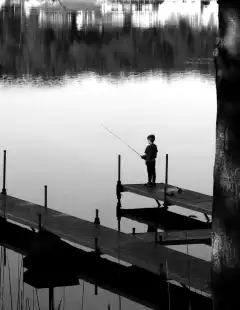
You must be logged in to post a comment.